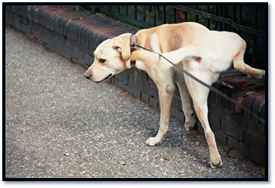Canine Bladder Infections: Part II
by Nancy Kay, DVM
 This is a four part article: These articles will discuss diagnostic testing and treatment.
This is a four part article: These articles will discuss diagnostic testing and treatment.
Part I | PART II | Part III | Part IV
In the first article of this series you were introduced to the causes of canine bladder infections and their associated symptoms. This article will help you understand how canine bladder infections are accurately diagnosed. The process always begins with testing a urine sample.
Collection of urine samples for testing
If a bladder infection is suspected, testing the urine will be one of the first steps your veterinarian takes. There are a few different ways to collect urine from a dog.
A “free catch” sample involves catching some urine in a container as the dog urinates. The presence of bacteria in a free catch sample is nonspecific, meaning the bacteria might have originated anywhere en route to the collection container, including the bladder, urethra, vulva, prostate gland, and even the hair around the opening of the penis or vulva. In other words, bacteria found in a free catch sample may not be all that meaningful. Other possible downsides to collecting free catch urine samples are a wet hand and suspicious looks from the neighbors.
Urine can also be collected via catheterization. A plastic or rubber catheter is inserted into the end of the urethra and advanced forward into the urinary bladder. Once in the bladder, urine is withdrawn through the catheter. There are a few drawbacks to this sampling method. Most dogs experience some discomfort with the process. Additionally, it is tricky business finding the opening to the urethra in female dogs. And because the catheter comes in contact with the urethra and reproductive structures (vagina, penis, prostate gland) before reaching the bladder, one cannot be certain as to the origin of bacteria found in the urine sample.
The preferred method of urine collection is a technique called cystocentesis. This involves introducing a small needle directly into the urinary bladder. Urine is collected into a syringe attached to the needle. Other than the stress associated with restraint, there is typically no more discomfort for the dog than would be associated with a vaccination. The beauty of a cystocentesis sample is that, if bacteria are detected, one can be certain they were living in the bladder.
Diagnosis of infection
A bladder infection is definitively diagnosed when bacteria are identified within a urine sample that has been collected via cystocentesis. Supporting evidence of infection includes the presence of red blood cells and excessive white blood cells and/or protein within the urine. Keep in mind, these ancillary abnormalities can occur with a variety of urinary tract diseases other than infection.
Bacteria in the urine can be documented by two tests: urinalysis and urine culture. The combination of the two is always ideal. A urinalysis measures urine concentration and pH, screens for red blood cells, white blood cells and protein, and involves viewing the urine sample under the microscope. While this test is relatively reliable, it can produce false negative results particularly if the urine sample sits for several hours prior to testing (certainly the case when samples are sent to a commercial laboratory rather than tested in house). Over time, the bacteria have a way of disappearing from view. Additionally, if the urine sample is dilute (more water than sludge), small numbers of bacteria can readily be missed during the microscopic evaluation.
The gold standard method for documentation of bacterial infection is a urine culture. Urine is inoculated onto agar and incubated for 48 to 72 hours. This way, the growth of bacteria can be documented, and identification and sensitivity testing can be performed. These tests clarify the species of bacteria growing as well as which antibiotics the bugs are sensitive to. This is super important information, particularly when treating dogs with recurrent bladder infections.
Has your dog ever had a bladder infection? If so, what symptoms did you observe?
CREDIT:
Dr. Nancy Kay, DVM Diplomate, American College of Veterinary Internal Medicine.
Recipient, American Animal Hospital Association 2009 Animal Welfare and Humane Ethics Award Recipient, 2009 Dog Writers Association of America Award for Best Blog Recipient, 2009 Eukanuba Canine Health Award
 Author of Speaking for Spot: Be the Advocate Your Dog Needs to Live a Happy, Healthy, Longer Life
Author of Speaking for Spot: Be the Advocate Your Dog Needs to Live a Happy, Healthy, Longer Life
Website: http://speakingforspot.com
Spot’s Blog: "http://www.speakingforspot.com/blog
Email: dr.kay@speakingforspot.com
Become a Facebook Fan: Facebook Fan - Nancy-Kay
 This is a four part article: These articles will discuss diagnostic testing and treatment.
This is a four part article: These articles will discuss diagnostic testing and treatment.Part I | PART II | Part III | Part IV
In the first article of this series you were introduced to the causes of canine bladder infections and their associated symptoms. This article will help you understand how canine bladder infections are accurately diagnosed. The process always begins with testing a urine sample.
Collection of urine samples for testing
If a bladder infection is suspected, testing the urine will be one of the first steps your veterinarian takes. There are a few different ways to collect urine from a dog.
A “free catch” sample involves catching some urine in a container as the dog urinates. The presence of bacteria in a free catch sample is nonspecific, meaning the bacteria might have originated anywhere en route to the collection container, including the bladder, urethra, vulva, prostate gland, and even the hair around the opening of the penis or vulva. In other words, bacteria found in a free catch sample may not be all that meaningful. Other possible downsides to collecting free catch urine samples are a wet hand and suspicious looks from the neighbors.
Urine can also be collected via catheterization. A plastic or rubber catheter is inserted into the end of the urethra and advanced forward into the urinary bladder. Once in the bladder, urine is withdrawn through the catheter. There are a few drawbacks to this sampling method. Most dogs experience some discomfort with the process. Additionally, it is tricky business finding the opening to the urethra in female dogs. And because the catheter comes in contact with the urethra and reproductive structures (vagina, penis, prostate gland) before reaching the bladder, one cannot be certain as to the origin of bacteria found in the urine sample.
The preferred method of urine collection is a technique called cystocentesis. This involves introducing a small needle directly into the urinary bladder. Urine is collected into a syringe attached to the needle. Other than the stress associated with restraint, there is typically no more discomfort for the dog than would be associated with a vaccination. The beauty of a cystocentesis sample is that, if bacteria are detected, one can be certain they were living in the bladder.
Diagnosis of infection
A bladder infection is definitively diagnosed when bacteria are identified within a urine sample that has been collected via cystocentesis. Supporting evidence of infection includes the presence of red blood cells and excessive white blood cells and/or protein within the urine. Keep in mind, these ancillary abnormalities can occur with a variety of urinary tract diseases other than infection.
Bacteria in the urine can be documented by two tests: urinalysis and urine culture. The combination of the two is always ideal. A urinalysis measures urine concentration and pH, screens for red blood cells, white blood cells and protein, and involves viewing the urine sample under the microscope. While this test is relatively reliable, it can produce false negative results particularly if the urine sample sits for several hours prior to testing (certainly the case when samples are sent to a commercial laboratory rather than tested in house). Over time, the bacteria have a way of disappearing from view. Additionally, if the urine sample is dilute (more water than sludge), small numbers of bacteria can readily be missed during the microscopic evaluation.
The gold standard method for documentation of bacterial infection is a urine culture. Urine is inoculated onto agar and incubated for 48 to 72 hours. This way, the growth of bacteria can be documented, and identification and sensitivity testing can be performed. These tests clarify the species of bacteria growing as well as which antibiotics the bugs are sensitive to. This is super important information, particularly when treating dogs with recurrent bladder infections.
Has your dog ever had a bladder infection? If so, what symptoms did you observe?
CREDIT:
Dr. Nancy Kay, DVM Diplomate, American College of Veterinary Internal Medicine.
Recipient, American Animal Hospital Association 2009 Animal Welfare and Humane Ethics Award Recipient, 2009 Dog Writers Association of America Award for Best Blog Recipient, 2009 Eukanuba Canine Health Award
 Author of Speaking for Spot: Be the Advocate Your Dog Needs to Live a Happy, Healthy, Longer Life
Author of Speaking for Spot: Be the Advocate Your Dog Needs to Live a Happy, Healthy, Longer LifeWebsite: http://speakingforspot.com
Spot’s Blog: "http://www.speakingforspot.com/blog
Email: dr.kay@speakingforspot.com
Become a Facebook Fan: Facebook Fan - Nancy-Kay
